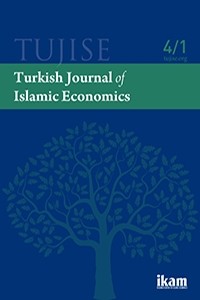IBN-İ HALDUN’UN VERGİLEME TEORİSİ VE ÖNEMİ
14yy’ın Kuzey Afrikalı çok yönlü dahi âlimi Ibn-i Haldun, ortaçağın en görkemli entelektüel başarılarından biri olduğu kabul edilen ünlü eseri Mukaddime’yi yazdı. Bu eser, tarih, psikoloji, sosyoloji, coğrafya, iktisat, siyaset vs. gibi pek çok bilimin hazinesidir. O bu kitapta, çalışma şevkinin kırılmaması ve gönül rızasıyla ödenebilmesi için vergi oranının düşük olması gerektiğini savunmuştur. Onun vergi teorisi iktisadi düşünce tarihine önemli bir katkıdır. Yüksek vergi oranlarının ekonomik faaliyetleri daraltarak vergi tabanını aşındırdığı görüşünü savunanların öncüsüdür. Laffer eğrisinin öncüsü olarak kabul edilmektedir. İktisadi büyüme için müşevviklerin ve vergi indirimlerinin önemini ifade eden arz yanlı iktisatla fikirleri uyuşmaktadır.
Anahtar Kelimeler:
İbn-i Haldun, Reganomiks, Vergi Teorisi, Arz Yanlı İktisat
IBN KHALDUN’S THEORY OF TAXATION AND ITS RELEVANCE
Ibn Khaldun, the North African versatile genius scholar of fourteenth century produced his famous work ‘al-Muqaddimah’ (the Introduction) which is considered as one of the most sublime and intellectual achievements of the Middle Ages. It is a treasury of many sciences like history, psychology, sociology, geography, economics, political sciences, etc. He strongly argued in this book for low tax rate so that incentive to work is not killed and taxes are paid happily. His theory of taxation is an important contribution to economic thought. He is forerunner of the idea that high tax rates shrink the tax base because they reduce the economic activity. He is considered as the forerunner of Laffer’s curve. His ideas are comparable with those of supply-side economics that emphasised incentives and tax cuts as a means of economic growth.
Keywords:
Ibn Khaldun, Reaganomics, Theory of Taxation, Supply-side Economics,
___
- Abbadi, Suleiman, ‘Ibn Khaldun Contribution to the Science Economics’, Journal of Al- Azhar University, Vol. 7 (1),2004, P 41-48.
- Abdul-Qadir (1941), ‘The Social and Political Ideas of Ibn Khaldun’, Indian Journal of Political Science, Vol. 3 (2) 1941, pp. 898-907.
- Baeck, Louis, The Mediterranean Tradition in Economic Thought, London /New York, 1994.
- Boulakia, Jean David C. ‘Ibn Khaldun: A Fourteenth Century Economist’, Journal of Political Economy, Vol. 79, (5), Sept./Oct.1971, pp. 1105-1118.
- Chapra, M. Umer, The Future of Economics: An Islamic Perspective, Leicester, U.K. 2000.
- Gibb, “The Islamic Background of Ibn Khaldun’s Political Theory”, in J. Shaw and W. R. Polk eds. Studies on the Civilization of Islam, , Boston, 1962, pp. 166-175.
- Gwartney, James D. (2006), ‘Supply-Side Economics’ (internet accessed on 15th June 2006), http://www.econlib.org/LIBRARY/Enc/SupplySideEconomics.html
- Ibn Khaldun, Muqaddimah of Ibn Khaldun, (An Introduction to History) Translated by Rosenthal, F., New York, 1958.
- Ibn Taymiyah, Majmu’ Fatawa Shaykh al-Islam, Riyadh, 1963, Vol. 30.
- Irving, T. B. ‘Ibn Khaldun on Agriculture’, Islamic Literature, Lahore, Vol. 7 (8), 1955, pp.31-32.
- Islahi, Abdul Azim, Economic Concepts of Ibn Taimiyah, Leicester, U.K. 1988.
- Issawi, Charles, An Arab Philosophy of History: Selection from the Prolegomena of Ibn Khaldun of Tunis (1332-1406) (translation and arrangement), London, 1950.
- Lacoste, Yves, Ibn Khaldun: The Birth of History and the Past of the Third World, London, 1984.
- Laffer, Arthur B. (2004), ‘The Laffer Curve: Past, Present, and Future’ (internet access on 15th June 2006), http://www.heritage.org/Research/Taxes/bg1765.cfm
- Lipsey, Richard G., and Streiner, Peter O. Economics, New York, 1981.
- Nagarajan, K. V. ‘Ibn Khaldun and 'supply-side economics': a note, Journal of Post Keynesian Economics, Vol. 5 (1), 1982, pp. 117-119.
- Nash’at, Muhammad Ali, al-Fikr al-Iqtisadi fi Muqaddimat Ibn Khaldun (Economic Thought in the Prolegomena of Ibn Khaldun), Cairo, 1944).
- Rabi‘, Muhammad Mahmoud, The Political Theory of Ibn Khaldun, Leiden, 1967.
- Rif‘at, Syed Mubariz al-Din, “Ma‘ashiyat par Ibn Khaldun ke Khayalat” (Ibn Khaldun’s Views on Economics), Ma‘arif (Azamgarh, India), Vol. 40 (1), 1937, pp. 16-28; August Vol. 40 (2), 1937, pp. 85-95.
- Rosenthal, F. Tr. Muqaddimah of Ibn Khaldun (An Introduction to History), New York, 1967, 3 volumes.
- Salih, Muhammad Zaki (1933), ‘al-Fikr al-Iqtisadi al-‘Arabi fi’l-Qarn al-Khamis ‘Ashar’ (Arab Economic Thought in the Fifteenth Century), Majallat al-Qanun Wa’l-Iqtisad, Cairo, Vol. 3 (3), 1933, pp. 315-360 and October, Vol. 3 (6), 1933), pp. 755-809.
- Sharif, M. Raihan, ‘Ibn Khaldun the pioneer Economist’, Islamic Literature, Lahore, Vol.6, (5), 1955, pp. 33-40.
- Siddiqi, M.N. ‘Recent Works on History of Economic Thought in Islam: a Survey’, in Sadeq and Ghazali, edts. Readings in Islamic Economic Thought, Selangor, Malaysia, 1992, pp. 33-58.
- Smith, Adam, An Inquiry into the Nature and Causes of the Wealth of Nations, New York: 1937.
- Spengler, Joseph J., ‘Economic Thought of Islam: Ibn Khaldun’, Comparative Studies in Society and History (The Hague), Vol. 6, 1964, pp. 268-306.
- Toynbee, Arnold J., A Study of History, London, Royal Institute of International Affairs and Oxford, 2nd ed. Vol. 3, 1935, p. 321-322.
- Wanniski, Jude, ‘Taxes, Revenues, and the `Laffer Curve,’ The Public Interest, Vol. 50, Winter 1978, pp. 3-16.
- Başlangıç: 2014
- Yayıncı: Research Center for Islamic Economics (ikam)
